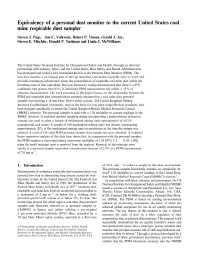Mining Publication: Equivalency of a Personal Dust Monitor to the Current United States Coal Mine Respirable Dust Sampler
Original creation date: January 2008
The United States National Institute for Occupational Safety and Health, through an informal partnership with industry, labor, and the United States Mine Safety and Health Administration, has developed and tested a new instrument known as the Personal Dust Monitor (PDM). The new dust monitor is an integral part of the cap lamp that coal miners normally carry to work and provides continuous information about the concentration of respirable coal mine dust within the breathing zone of that individual. Previous laboratory testing demonstrated that there is a 95% confidence that greater than 95% of individual PDM measurements fall within ± 25% of reference measurements. The work presented in this paper focuses on the relationship between the PDM and respirable dust concentrations currently measured by a coal mine dust personal sampler unit utilizing a 10 mm Dorr-Oliver nylon cyclone. The United Kingdom Mining Research Establishment instrument, used as the basis for coal mine respirable dust standards, had been designed specifically to match the United Kingdom British Medical Research Council (BMRC) criterion. The personal sampler is used with a 1.38 multiplier to convert readings to the BMRC criterion. A stratified random sampling design incorporating a proportionate allocation strategy was used to select a sample of mechanized mining units representative of all US underground coal mines. A sample of 180 mechanized mining units was chosen, representing approximately 20% of the mechanized mining units in production at the time the sample was selected. A total of 129 valid PDM/personal sampler dust sample sets were obtained. A weighted linear regression analysis of this data base shows that, in comparison with the personal sampler, the PDM requires a mass equivalency conversion multiplier of 1.05 [95% C.I. = (1.03, 1.08)] when the small intercept term is removed from the analysis. Removal of the intercept term results in a personal sampler-equivalent concentration increase of 2.9% at a PDM measurement of 2.0 mg m-3.
Authors: SJ Page, JC Volkwein, RP Vinson, GJ Joy, SE Mischler, DP Tuchman, LJ McWilliams
Peer Reviewed Journal Article - January 2008
NIOSHTIC2 Number: 20033402
J Environ Monit 2008 Jan; 10(1):96-101
See Also
- Best Practices for Dust Control in Coal Mining
- Determining the Spatial Variability of Personal Sampler Inlet Locations
- Enhanced Utilization of Personal Dust Monitor Feedback
- Evaluation of the Approach to Respirable Quartz Exposure Control in U.S. Coal Mines
- Exposure Monitoring of Dust and Toxic Substances
- Investigation of Coal Properties and Airborne Respirable Dust Generation
- Laboratory Evaluation of Pressure Differential-based Respirable Dust Detector Tube
- Miners' Views about Personal Dust Monitors
- Miners' Views About Personal Dust Monitors
- Performance of a New Personal Respirable Dust Monitor for Mine Use
- Respirable Dust
- Respirable Quartz Hazard Associated with Coal Mine Roof Bolter Dust
- Content source: National Institute for Occupational Safety and Health, Mining Program


 ShareCompartir
ShareCompartir
